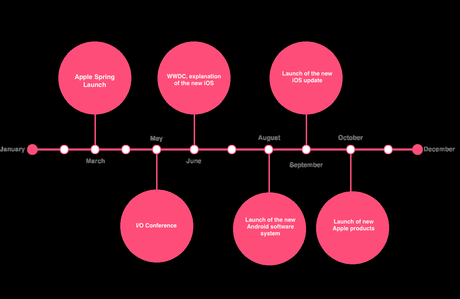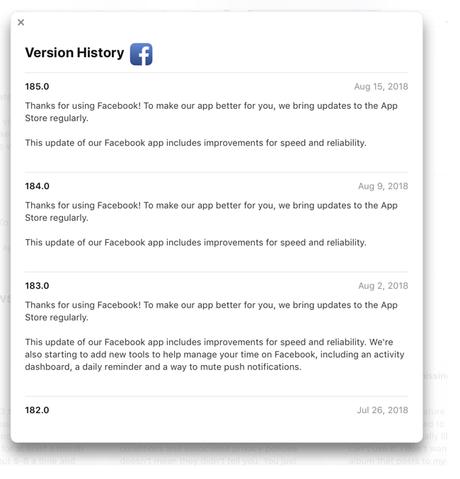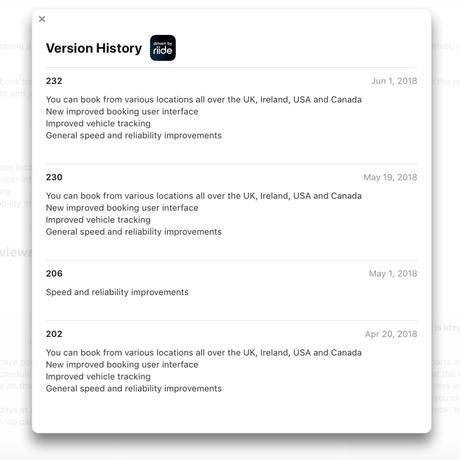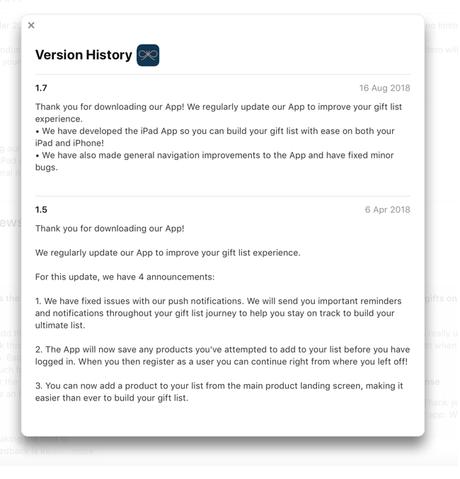No matter how much you’ve invested in building your new app, how smooth-running and shiny it is, it’s going to run into problems. Potentially serious ones. And the only real way to address them is through app store updates.
In this blog post we answer the following questions:
- What exactly do updates do?
- How to identify bugs?
- How often should we update?
- Release notes: Does anyone read them?
- Who updates it, and how much is it going to cost?
What exactly do updates do?
We can break down updates into two main types: major and minor. Major updates include whole new versions of your app, which usually involve a serious overhaul of your apps interface, look and feel. Major updates also address new features. Minor updates, on the other hand, deal with the kind of niggling, day-to-day bugs that impair what should otherwise be an enjoyable and intuitive experience for the user.
It helps to think of your app as a new car. It’s not all scenic drives in the country. You need to check the oil, change the brake pads and tires, and wash the thing from time to time. Minor updates are crucial; they’re the regular maintenance that keep your app running smoothly. If you’re not allocating time and resources to this, sooner or later, your app will end up on the scrap heap.
Software might not damage in the same way a car does, but it evolves. And pretty quickly. As handsets change, OS and server updates get released, bugs tend to come out of the woodwork. Not great news for usability and customer experience, but also potentially risky. Even though Apple and Google are good at rolling out security patches, leave it too long and your app will be out-of-date and vulnerable to attacks.
Major updates
– New features
– UI revamp
– App re-launch to re-engage users
– Integration with a third-party service
– Illustrated by version numbers changing with 1.0
Minor updates
– Bug fix
– A/B test UI element
– Terms update
– Minor feature changes
– Illustrated by version numbers changing with 0.1
How to identify bugs?
There are two ways to do this. The first is through testing. If your app has made it to the store, then it’s probably been put through its paces already. But, in order to get real quantitative data on the functionality of your app, testing needs to be done regularly. At Nodes, we have a number of methods to track and analyze app-related data.
Among all these methods, good old-fashioned A/B testing is always a reliable first port of call. But, to get more focused data, you’ll need to look at funnels. These are incredibly useful for observing how people are using your app, from download to in-app purchase. They track user movements along every step of that process, so if there are any roadblocks, or your customers are somehow getting lost along the way, we’ll soon find out why. An invaluable tool when it comes to judging the effectiveness of your apps structure, funnels help target problem spots, improve conversion rates, and streamline the journey from homepage to checkout.
However, as crucial as testing is, it can never truly replicate real-world user experience. Which brings us to the second method: user feedback.
App store reviews are a vital source of qualitative data. Users don’t tend to hold back. Though they might not always be super polite, users are your best friend. And they appreciate being heard. Think of it this way: if a user specifies a bug which is subsequently fixed with an update, it’s not only going to improve general usability, it’s also going to foster an important relationship with your user base. Your customers will feel like they’re being listened to, which will mean a greater level of trust, and, ultimately, loyalty to your brand.
How often should we update?
There’s no real consensus on this. Big hitters like Facebook update weekly. For the most part, these tend to be minor updates for bug fixes and usability. Obviously the scale and purpose of your app, number of users, and features are all important considerations. But so is the type of update.
 > What are App Store Updates and why are they needed?" />> What are App Store Updates and why are they needed?" data-rjs="https://www.nodesagency.com/wp-content/uploads/2018/08/Screen-Shot-2018-08-24-at-13.07.47.png" height="512" width="2032" alt="Screen Shot 2018 08 24 at 13.07.47 - What are App Store Updates and why are they needed?" srcset="https://qu6oa42ax6a2pyq2c11ozwvm-wpengine.netdna-ssl.com/wp-content/uploads/2018/08/Screen-Shot-2018-08-24-at-13.07.47.png 2032w, https://qu6oa42ax6a2pyq2c11ozwvm-wpengine.netdna-ssl.com/wp-content/uploads/2018/08/Screen-Shot-2018-08-24-at-13.07.47-300x76.png 300w, https://qu6oa42ax6a2pyq2c11ozwvm-wpengine.netdna-ssl.com/wp-content/uploads/2018/08/Screen-Shot-2018-08-24-at-13.07.47-768x194.png 768w, https://qu6oa42ax6a2pyq2c11ozwvm-wpengine.netdna-ssl.com/wp-content/uploads/2018/08/Screen-Shot-2018-08-24-at-13.07.47-1024x258.png 1024w" class="vc_single_image-img attachment-full" />
> What are App Store Updates and why are they needed?" />> What are App Store Updates and why are they needed?" data-rjs="https://www.nodesagency.com/wp-content/uploads/2018/08/Screen-Shot-2018-08-24-at-13.07.47.png" height="512" width="2032" alt="Screen Shot 2018 08 24 at 13.07.47 - What are App Store Updates and why are they needed?" srcset="https://qu6oa42ax6a2pyq2c11ozwvm-wpengine.netdna-ssl.com/wp-content/uploads/2018/08/Screen-Shot-2018-08-24-at-13.07.47.png 2032w, https://qu6oa42ax6a2pyq2c11ozwvm-wpengine.netdna-ssl.com/wp-content/uploads/2018/08/Screen-Shot-2018-08-24-at-13.07.47-300x76.png 300w, https://qu6oa42ax6a2pyq2c11ozwvm-wpengine.netdna-ssl.com/wp-content/uploads/2018/08/Screen-Shot-2018-08-24-at-13.07.47-768x194.png 768w, https://qu6oa42ax6a2pyq2c11ozwvm-wpengine.netdna-ssl.com/wp-content/uploads/2018/08/Screen-Shot-2018-08-24-at-13.07.47-1024x258.png 1024w" class="vc_single_image-img attachment-full" />
This graph shows how many times 3 different apps push updates to their users.
Feature updates usually involve quite a bit of planning, work, and testing. Before launching a new feature, you want to be absolutely sure that it’s working as it should be. A rushed feature update could end in disaster, with your team scrambling to fix something that could have been covered in the pre-launch phase. Minor updates are different. Once you’re happy with the functionality of your new features, minor updates ensure their stability. These need to happen frequently. At least once a month. Your testing and customer feedback should be telling you where things are going wrong, and will help you plan your future updates.
This is where a roadmap comes in handy. Use it to schedule the different types of updates you’ve got planned, from major to minor. That way you’ve got scope to work on the big new rollouts, with enough time and breathing space to tackle the unexpected. Also, bear in mind your overarching marketing strategy. If it’s out of synch with your update release schedule, there’s the potential for some embarrassing confusion.
 > What are App Store Updates and why are they needed?" />> What are App Store Updates and why are they needed?" data-rjs="https://www.nodesagency.com/wp-content/uploads/2018/08/Timelinelaunch-v2.png" height="836" width="1285" alt="Timelinelaunch v2 - What are App Store Updates and why are they needed?" srcset="https://qu6oa42ax6a2pyq2c11ozwvm-wpengine.netdna-ssl.com/wp-content/uploads/2018/08/Timelinelaunch-v2.png 1285w, https://qu6oa42ax6a2pyq2c11ozwvm-wpengine.netdna-ssl.com/wp-content/uploads/2018/08/Timelinelaunch-v2-300x195.png 300w, https://qu6oa42ax6a2pyq2c11ozwvm-wpengine.netdna-ssl.com/wp-content/uploads/2018/08/Timelinelaunch-v2-768x500.png 768w, https://qu6oa42ax6a2pyq2c11ozwvm-wpengine.netdna-ssl.com/wp-content/uploads/2018/08/Timelinelaunch-v2-1024x666.png 1024w" class="vc_single_image-img attachment-full" />
> What are App Store Updates and why are they needed?" />> What are App Store Updates and why are they needed?" data-rjs="https://www.nodesagency.com/wp-content/uploads/2018/08/Timelinelaunch-v2.png" height="836" width="1285" alt="Timelinelaunch v2 - What are App Store Updates and why are they needed?" srcset="https://qu6oa42ax6a2pyq2c11ozwvm-wpengine.netdna-ssl.com/wp-content/uploads/2018/08/Timelinelaunch-v2.png 1285w, https://qu6oa42ax6a2pyq2c11ozwvm-wpengine.netdna-ssl.com/wp-content/uploads/2018/08/Timelinelaunch-v2-300x195.png 300w, https://qu6oa42ax6a2pyq2c11ozwvm-wpengine.netdna-ssl.com/wp-content/uploads/2018/08/Timelinelaunch-v2-768x500.png 768w, https://qu6oa42ax6a2pyq2c11ozwvm-wpengine.netdna-ssl.com/wp-content/uploads/2018/08/Timelinelaunch-v2-1024x666.png 1024w" class="vc_single_image-img attachment-full" />
Expect Apple and Google to launch updates and new products during each year. Make sure you have those yearly events and launches as a part of your maintenance plan.
Release notes: Does anyone read them?
The short is answer is, sort of. Scroll through the app store and you’ll see lots of different approaches to the question of release notes. Some companies include a detailed and technical explanation of the update. Others will write something generic and vague. Some are dry and full of jargon, others are light-hearted and even irreverent.
 > What are App Store Updates and why are they needed?" />> What are App Store Updates and why are they needed?" height="497" width="743" alt="Forside.history - What are App Store Updates and why are they needed?" srcset="https://qu6oa42ax6a2pyq2c11ozwvm-wpengine.netdna-ssl.com/wp-content/uploads/2018/08/Forside.history.jpg 743w, https://qu6oa42ax6a2pyq2c11ozwvm-wpengine.netdna-ssl.com/wp-content/uploads/2018/08/Forside.history-300x201.jpg 300w" class="attachment-full" />
> What are App Store Updates and why are they needed?" />> What are App Store Updates and why are they needed?" height="497" width="743" alt="Forside.history - What are App Store Updates and why are they needed?" srcset="https://qu6oa42ax6a2pyq2c11ozwvm-wpengine.netdna-ssl.com/wp-content/uploads/2018/08/Forside.history.jpg 743w, https://qu6oa42ax6a2pyq2c11ozwvm-wpengine.netdna-ssl.com/wp-content/uploads/2018/08/Forside.history-300x201.jpg 300w" class="attachment-full" />
 > What are App Store Updates and why are they needed?" />> What are App Store Updates and why are they needed?" height="677" width="650" alt="Fb.his - What are App Store Updates and why are they needed?" srcset="https://qu6oa42ax6a2pyq2c11ozwvm-wpengine.netdna-ssl.com/wp-content/uploads/2018/08/Fb.his_.jpg 650w, https://qu6oa42ax6a2pyq2c11ozwvm-wpengine.netdna-ssl.com/wp-content/uploads/2018/08/Fb.his_-288x300.jpg 288w" class="attachment-full" />
> What are App Store Updates and why are they needed?" />> What are App Store Updates and why are they needed?" height="677" width="650" alt="Fb.his - What are App Store Updates and why are they needed?" srcset="https://qu6oa42ax6a2pyq2c11ozwvm-wpengine.netdna-ssl.com/wp-content/uploads/2018/08/Fb.his_.jpg 650w, https://qu6oa42ax6a2pyq2c11ozwvm-wpengine.netdna-ssl.com/wp-content/uploads/2018/08/Fb.his_-288x300.jpg 288w" class="attachment-full" />
 > What are App Store Updates and why are they needed?" />> What are App Store Updates and why are they needed?" height="658" width="657" alt="Riide.his - What are App Store Updates and why are they needed?" srcset="https://qu6oa42ax6a2pyq2c11ozwvm-wpengine.netdna-ssl.com/wp-content/uploads/2018/08/Riide.his_.jpg 657w, https://qu6oa42ax6a2pyq2c11ozwvm-wpengine.netdna-ssl.com/wp-content/uploads/2018/08/Riide.his_-150x150.jpg 150w, https://qu6oa42ax6a2pyq2c11ozwvm-wpengine.netdna-ssl.com/wp-content/uploads/2018/08/Riide.his_-300x300.jpg 300w" class="attachment-full" />
> What are App Store Updates and why are they needed?" />> What are App Store Updates and why are they needed?" height="658" width="657" alt="Riide.his - What are App Store Updates and why are they needed?" srcset="https://qu6oa42ax6a2pyq2c11ozwvm-wpengine.netdna-ssl.com/wp-content/uploads/2018/08/Riide.his_.jpg 657w, https://qu6oa42ax6a2pyq2c11ozwvm-wpengine.netdna-ssl.com/wp-content/uploads/2018/08/Riide.his_-150x150.jpg 150w, https://qu6oa42ax6a2pyq2c11ozwvm-wpengine.netdna-ssl.com/wp-content/uploads/2018/08/Riide.his_-300x300.jpg 300w" class="attachment-full" />
 > What are App Store Updates and why are they needed?" />> What are App Store Updates and why are they needed?" height="677" width="650" alt="WH.his - What are App Store Updates and why are they needed?" srcset="https://qu6oa42ax6a2pyq2c11ozwvm-wpengine.netdna-ssl.com/wp-content/uploads/2018/08/WH.his_.jpg 650w, https://qu6oa42ax6a2pyq2c11ozwvm-wpengine.netdna-ssl.com/wp-content/uploads/2018/08/WH.his_-288x300.jpg 288w" class="attachment-full" />
> What are App Store Updates and why are they needed?" />> What are App Store Updates and why are they needed?" height="677" width="650" alt="WH.his - What are App Store Updates and why are they needed?" srcset="https://qu6oa42ax6a2pyq2c11ozwvm-wpengine.netdna-ssl.com/wp-content/uploads/2018/08/WH.his_.jpg 650w, https://qu6oa42ax6a2pyq2c11ozwvm-wpengine.netdna-ssl.com/wp-content/uploads/2018/08/WH.his_-288x300.jpg 288w" class="attachment-full" />
It helps to know your audience. If your customer base is particularly tech-savvy, they’ll probably look forward to some detailed notes. But don’t assume that engineers and tech geeks are the only ones reading. Your regular user will appreciate a heads-up on the specific issues you’ve fixed. Release notes give even the most cursory reader a reason to tap that update button. Perhaps they love or hate a certain feature, have a security concern, or are encountering problems running the app on their particular device. This even applies to the increasing number of users running automatic updates. If, for example, you’ve decided to start running ads, your users deserve to know.
Either way, it’s all about building a relationship with your customer. Imagine this scenario: you’ve downloaded an app, and after playing around with it for a while, you spot a bug. You then decide to let the company know in an app store review. Two weeks later, they drop a new update, and, lo and behold, there in the release notes is a fix for the bug you reported. That’s a great feeling. You know that you’re being listened to, that the company values your feedback, and that they are committed to improving your experience.
Who updates it, and how much is it going to cost?
First of all, let’s make something clear: a budget for maintenance updates is essential. To revisit the car analogy, imagine not spending any money on the upkeep of your new car. It won’t be long before the clutch starts slipping, the tyres start balding, and the windows stop going up and down. This budget should be incorporated, right from the very start, as part of the overall costs of developing your app. Of the initial investment on development, you should be allocating about 15 to 20 percent of that to yearly maintenance costs.
Of course, each app is different. One with very basic features is probably not going to need quite as much maintenance as a more sophisticated and nuanced one. This is where it makes sense to defer to the experts.
An agency dedicated to app development is going to know exactly how and when updates should be implemented, and, crucially, test them before they’re released. They’ll be able to break down all the nuances of your app and how it works within the larger framework of your business, giving you a fully tailored plan of action. Of course, you’ll need to set aside a budget, but the actual cost is difficult to gauge without a thorough and professional analysis of your app.
But our app really is perfect!
We’re not saying it’s impossible, we’ve just never seen it. Put bluntly: There are always updates needed for an app.
Your app might pass every test with flying colours, but things are different out there in the real world. Nine times out of ten, your users are going to let you know what’s going on. But bugs have an annoying tendency to slip by unnoticed. A lot of them immediately after a new version, or major feature update is released. It’s inevitable. Effective testing, tracking, and monitoring are your biggest allies. It’s all part of the process, and it’s important to remember why you decided to build an app in the first place: customers.
Apps are often used as a way of reaching out to potential customers. Once they’re on board, their first line of interaction with your company is going to be through that app. The app is not just there to serve its specific function, it’s there to represent your brand as a whole. It’s the modern-day storefront. So quality assurance is key. For some reason, owners and stakeholders have been slow to accept this, often content to outlay costs for development, but then reluctant to maintain a product they see as being completed. It’s a risky approach. Here’s why:
If your app is buggy and out-of-date, users will get frustrated, not just with your app, but with your entire company. First they’ll trash the app, then they’ll start taking their business elsewhere. Keep your app healthy and its code fresh, and you’ll have a happy base of dedicated customers who love your product and trust your brand.
Indlægget What are App Store Updates and why are they needed? blev først udgivet på Nodes UK.

